Joyful Infant Care at Horizons for Homeless Children
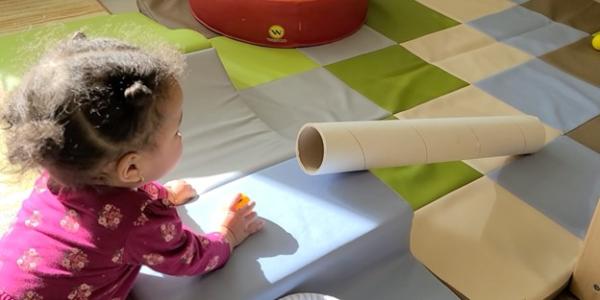
You are here
Amina, one of the newest infants in the class, is attempting to sit up. Teachers Rosis and Herb consider what spatial configurations and soft objects would encourage safe and active exploration at the child’s own pace. They then create options based on their thinking about what is responsive to her development. Amina will lean in different directions, so they set up “crash pads” with cushions. They also provide other options, such as surrounding her in a circle of their bent legs to provide a structure for maneuvering and placing her just inside the opening of a rigid sitting support ring. With the ability to fall safely, Amina learns to catch herself while developing the balance and core strength necessary to sit independently.
Horizons for Homeless Children is a child care program in Boston that provides early education opportunities for children and their families who might be in shelter or might have recently moved out of shelter. Families generally stay with us for several months after they find secure housing, and many of the children in our program have been with us from infancy through preschool. Because of this, the educational models we use are trauma-informed and focus on social and emotional development. We know that if we don’t get that piece right—if children don’t feel comfortable and content—learning will not take place. In this article, we share information about our program and offer specific examples of how we promote playful, trauma-informed infant care and education.
Trauma-Informed Teaching and Care of Infants
In addition to extensive training in trauma-informed care, our infant teaching team draws upon their diverse personal and professional backgrounds in family homelessness, child development, science, and art to create environments and curricula that encourage playful growth and learning. Although we do not adhere to one particular framework, everything we do is informed by various play-based learning approaches such as Reggio-Emilia, Montessori, and Creative Curriculum. We also draw from neuroscience and trauma research accessed from resources such as Harvard’s Center for the Developing Child’s online collection of articles (developingchild.harvard.edu).
Our training and experience inform us that children who have experienced instability or adverse childhood experiences (ACEs) at home often exhibit behaviors that may include overly active hands and feet (swirling, wringing, fidgeting); the need to have something in both hands at all times; prolonged crying, even after basic needs have been met; and the inability to focus. Educators and other early childhood professionals can use responsive tools and supports to meet young children’s social and emotional needs and to help children develop self-regulation (Powers, Ryan, & Lane 2017). In response to our children’s regulation needs, we work to keep commotion and chaos at a minimum so they can experience a calming environment that encourages them to explore. We focus on creating safe, stable, nurturing environments with rich learning experiences as well. This includes flexibility with nap times, soft music, lower volumes in the classroom, and lots of playful adult-child interactions that are sometimes directed and sometimes open-ended. When children feel safe, comfortable, and supported, they can play freely and joyfully.
We understand that behaviors linked to ACEs can be mitigated through sensory stimulation (Miller 2020; Powers, Ryan, & Lane 2017). Therefore, our curriculum contains many sensory activities. For example, we recently invited the children to play with cornstarch mixed with water, a seemingly simple tactile exploratory activity that the children found highly engaging. We provide the time and support necessary to promote an infant’s agency to explore, touch, and play because we know that many of our children don’t have access to these experiences where they live. Shelter environments and unstable housing situations may feel unsafe to young children and their families. In addition to lacking the proper space, many families don’t have the time to allow their infants to freely exercise their curiosity. In these situations, even floor play might be difficult to access for the young children in our program. However, in the classroom, free from worry and with sufficient time and resources, we can say “yes” to children’s ideas and investigations and approach children’s play with quiet vigilance based on our knowledge of the child and our environment.
Playful Learning with Open-Ended Materials
Meital, the article’s second author and lead teacher of our infant classrooms, has observed that play is how children learn, so we offer lots of child-led play in our program. If children are showing interest in an activity, we encourage it. Additionally, we often narrate their play in both Spanish and English: we talk about what they are doing and what we are doing, which promotes language. What we have found is that play activates multiple developmental domains.
In many of the playful learning experiences we facilitate in our classroom, we select open-ended materials that encourage children to investigate and explore safely. Recently, we invited children to engage with large cardboard boxes, balls, tubes, and ramps in various ways while we narrated their play activities.
Engaging with Others Through Streamers
We often use boxes in the infant room because they are versatile and can be repurposed. For example, one of our teachers recently brought a large box to the classroom, and another teacher (and third author), Rosis, thought to attach streamers to it. Rosis then set it on its side so children could play and interact with each other inside and outside the box as they moved through the streamers.
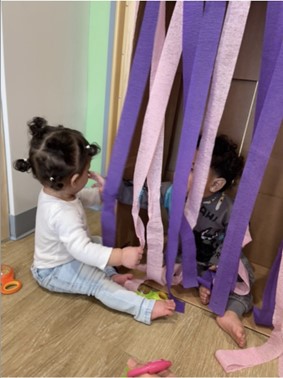
Repurposing the Box for Ball Play
The following week, after the children enjoyed pulling the streamers off, we cut holes in the sides of the box. In this repurposed environment, children, including Raydell, enjoyed interacting with each other and their teacher, Herb, by peering at one another and passing balls back and forth through the holes.
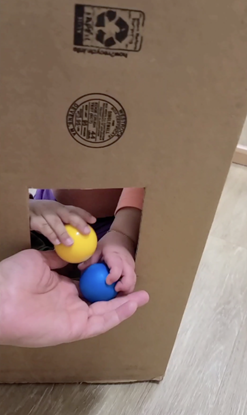
Raydell, an older infant who is 13 months, is inside the large cardboard box. His teacher, Herb, is on the other side looking through a hole. “Hola, Raydell.” Raydell looks through the hole and laughs. “Peek-a-boo!” Herb says. Raydell laughs again and puts his eye up to the hole. “Oh, you put your eye to the hole. Can you see me? I can see you.” Herb narrates as Raydell investigates. “Now you are putting your hand through the hole. Hello, Hola.” Herb offers Raydell the ball. “Do you want a ball? Quieres una pelota?” Raydell takes the ball from Herb and goes inside the box. “Raydell took the ball inside. Can Herb have the ball? Da me por favor?” Herb asks. There is hesitation, then Raydell pokes his hand back through the hole and drops the ball in his teacher’s hand. “Raydell gave me the ball. Graciás!” Herb says.
Using the Box for Sensory Bin Exploration and Play
Boxes can also provide a safe, enclosed space for exploration with materials that may be new to children. For instance, we put a sensory bin with a little cornstarch and water inside one of the large boxes and let the children mix and play.
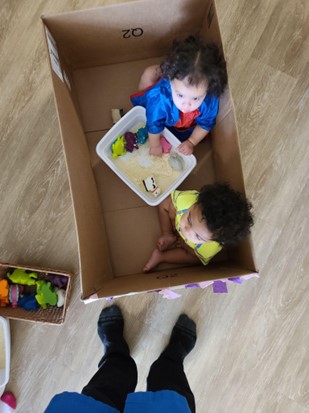
Using the Box for Color and Tactile Exploration with Paints
Paint is another material we have successfully incorporated into box play. Children can use their hands to paint boxes or large pieces of cardboard, feeling the texture of the paint while we talk about the colors they’re using.
Rosis squirts dollops of blue, yellow, and red paint onto a piece of large cardboard she removed from the box. She places it on the floor for the children’s easy access. “Bebes, vamos a pintar!” she calls to them. Selina, Paola, and Raydell crawl toward the makeshift canvas. The teachers ready them to paint, placing them around the cardboard. Paola reaches forward to touch the splotch of yellow paint. “You like the yellow paint, Paola? Tu quieres amarillo?” Rosis asks. After a few minutes of checking in with all the children, she asks “Como se siente bebes? How does it feel?”
Investigation with Ramps and Inclined Tubes
In our classroom, we love ramps! They not only help us create settings that children will encounter later on, but they also provide a play space for children at different levels of development. Younger infants can watch while older infants hold the ball and release it. Children can observe how balls roll down inclines and how balls look when we roll them back up.
We introduce children to ramps by putting out a PVC half-pipe, some large cardboard tubes, large pieces of cardboard, and balls on soft play mats. This is just what Herb did with a group of children, and each child actively engaged with these materials in different ways.
Herb places a ball in the tube, releases it, and lets it roll through the tube as the children watch. After his demonstration, the children take turns playing with the ball and inclined tube while Amina, who is 6 months, sits with Herb and tracks the ball’s movement. Paola, who is 11 months, holds the ball but won’t let it go in the tube. Instead, she pushes a different ball with her hand. Raydell, who is 13 months, puts the ball in the tube but isn’t ready to let go of it completely either. When Selena, who is 11 months, takes her turn, she lets the ball go and watches it glide down the tube. Later, Selena takes the tube from where the teachers set it up, sits on the floor, raises it, and puts the ball into it on her own, initiating ramp play independently.
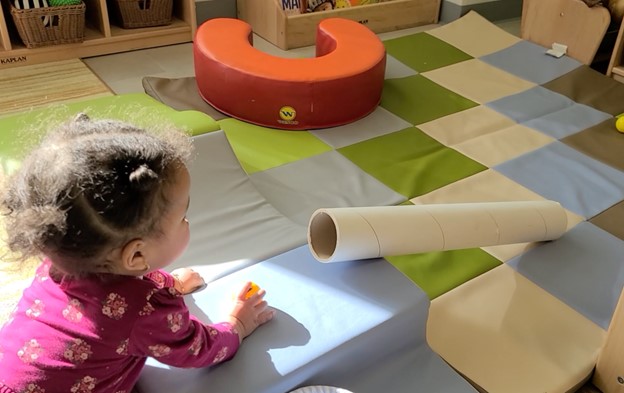
Conclusion
The use of boxes and inclines invites children to learn through play, resulting in the stimulation of several areas of development: the activation of cognitive skills through the exploration and the observation of cause and effect; the cultivation of fine and large motor skills through interactions with the materials; acquisition of language by hearing teachers narrate actions; and the fostering of trust and connection with peers and teachers.
In our classroom, we offer children open-ended materials, model some ways to use them, and then step back as they explore, curious to see how they’ll respond. What will happen with a bigger ball? What if we offer a different kind of tube? What will the children try, and how can we keep supporting their curiosity? We will continue to provide safe, joyful ways for children to explore within a developmentally appropriate environment, so they can learn, play, and thrive in our care.
Authors’ Note
We would like to acknowledge our colleague, Jorime Mileon, for her contributions to this article in its initial stages.
References
Miller, B.J. 2020. “ACE: A Recipe for Occupational Competence.” Occupational therapy doctorate capstone, University of Kentucky. https://encompass.eku.edu/otdcapstones/60.
Ryan, K., S.J. Lane, & D. Powers. 2017. “A Multidisciplinary Model for Treating Complex Trauma in Early Childhood.” International Journal of Play Therapy 26 (2): 111–123.
Herbert Hickey holds a master’s degree in early childhood education with the creative arts and a certificate in family homelessness. Herbert has over 10 years of experience in trauma-informed care at Horizons for Homeless Children, where he currently works in the infant classroom. [email protected]
Meital Sandbank holds a bachelor’s degree in human development and family studies with a concentration in early childhood development and education. She is currently pursuing her master of social work and is working as a program specialist focused on child development and trauma-informed care in a social work agency. Meital also worked as an education leader for a non-profit organization with children experiencing homelessness, overseeing the infant program. [email protected]
Rosis de Jesus has been an infant teacher at Horizons for Homeless Children for over a year and a half. Prior to her employment at HHC, she worked several years with infants and toddlers in other settings.